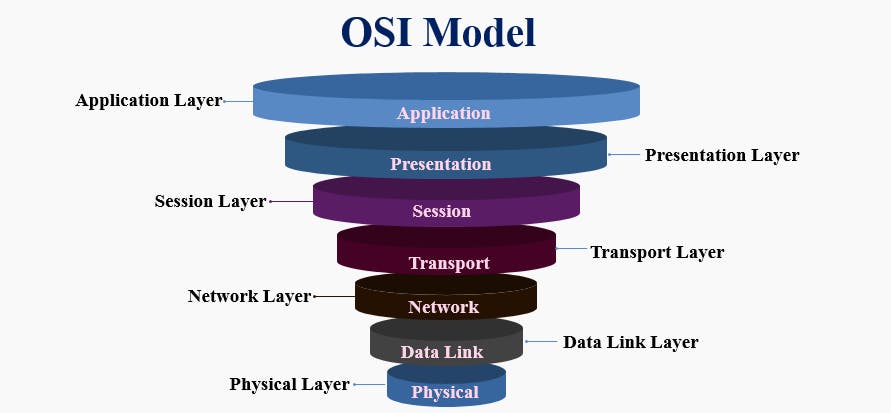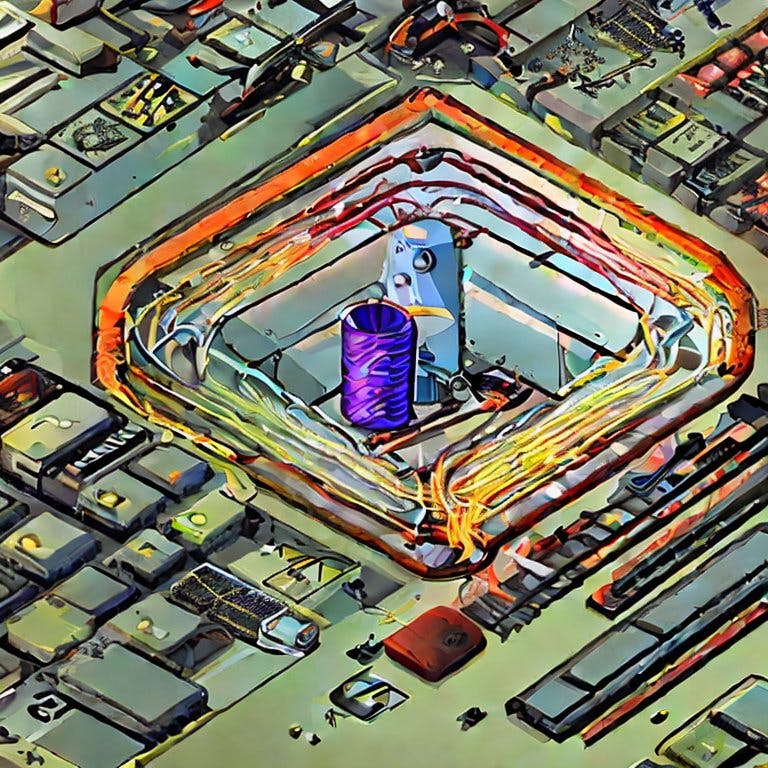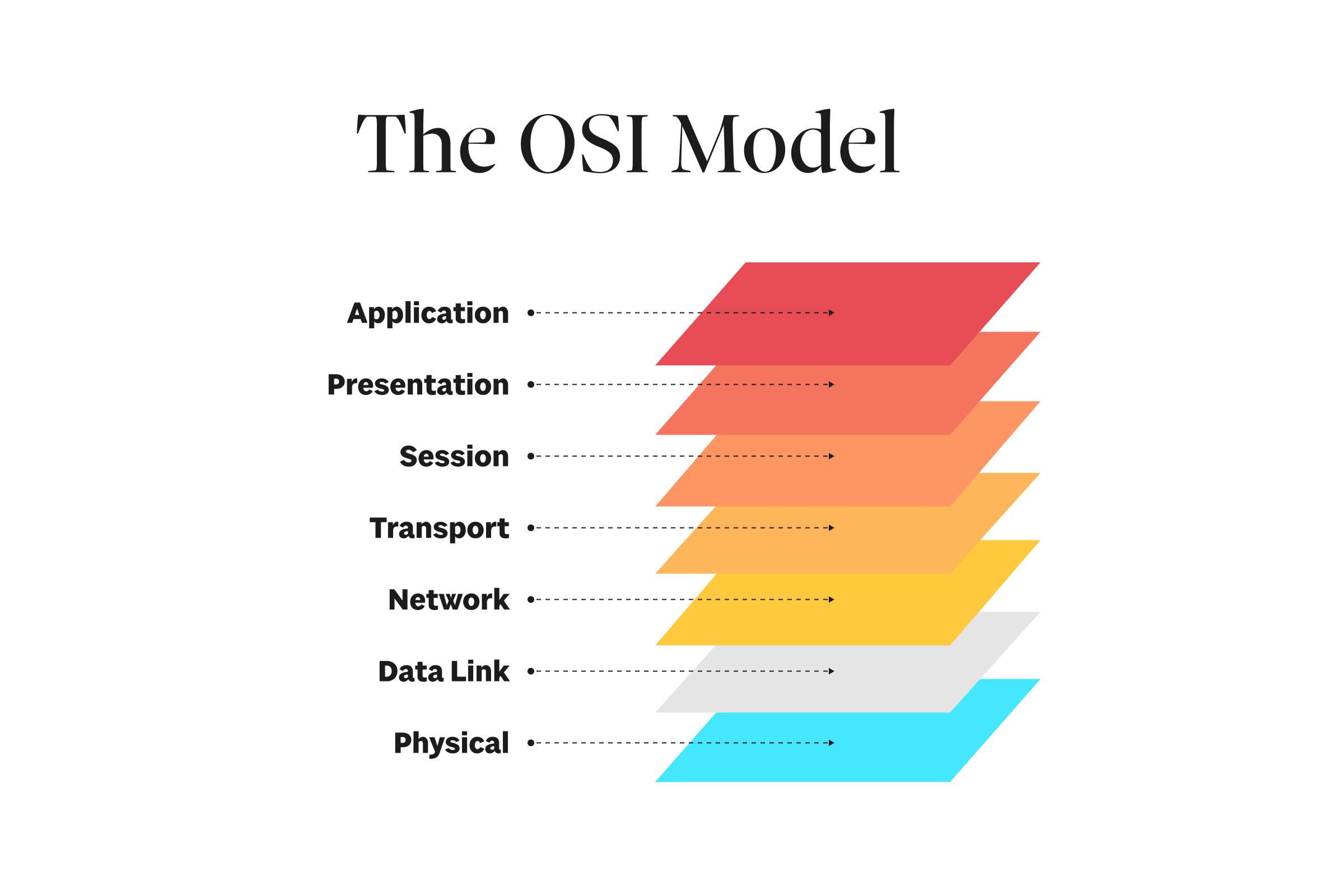
OSI model was developed by ISO and is generally used to comprehend and standardize communication channels and developer protocols. The history of the OSI model and ISO (International Organization for Standardization) is closely linked. In the late 1970s, there were multiple network protocols in use, and each vendor had their own proprietary protocols. This situation led to interoperability issues between different network equipment and protocols, making it challenging to create a seamless network communication system.
The birth of the OSI model:

To address these interoperability issues, the ISO established a working group in 1977 to develop a standardized model for network communication. This working group was called the Open Systems Interconnection (OSI) Reference Model Working Group, and it was tasked with creating a framework for network communication that would allow different protocols and equipment to communicate with each other.
The OSI Reference Model Working Group released the OSI model in 1984, which provided a structured framework for network communication, dividing it into seven distinct layers. The OSI model was designed to be a theoretical framework for network communication, providing a standard for network protocol development and equipment design.
Although the OSI model provided a detailed framework for network communication, it was not widely adopted by the networking industry. Instead, the TCP/IP model, which was already in use by the US Department of Defense, became the de facto model for network communication.
Despite its limited adoption, the OSI model has had a significant impact on the development of network communication. It provided a standard framework for network communication, allowing for the development of interoperable network protocols and equipment. The OSI model also influenced the development of other models, such as the TCP/IP model, which combined some of the OSI model's layers and became the foundation of the modern internet.
Layers in OSI model:

The Open Systems Interconnection (OSI) model provides us with a conceptual platform that describes the communication protocols used in computer networks. It is designed to standardize the communication between different computer systems, and it defines a layered approach to network communication. The OSI model consists of seven layers, each of which performs a specific set of functions in the network communication process.
The seven layers of the OSI model are:
Physical Layer: This layer is responsible for the physical transmission of data over the network. It defines the hardware specifications, such as cables, connectors, and network interface cards (NICs), and it converts the digital signals into analog signals for transmission over the network. Examples of applications that use the Physical layer include Ethernet, Token Ring, and Wi-Fi.
Data Link Layer: This layer is responsible for providing error-free communication between two adjacent devices on a network. It divides the data into frames and performs error checking and correction to ensure that the data is transmitted without errors. Examples of applications that use the Data Link layer include Ethernet, Token Ring, and Point-to-Point Protocol (PPP).
Network Layer: This layer is responsible for the routing of data between different networks. It defines the logical addressing scheme used to identify devices on the network and determines the optimal path for data to travel between devices. Examples of applications that use the Network layer include Internet Protocol (IP) and Open Shortest Path First (OSPF).
Transport Layer: This layer is responsible for ensuring reliable communication between two devices on a network. It provides end-to-end error recovery, flow control, and congestion control. Examples of applications that use the Transport layer include Transmission Control Protocol (TCP) and User Datagram Protocol (UDP).
Session Layer: This layer is responsible for managing the communication between two devices on a network. It establishes, maintains, and terminates communication sessions, and it ensures that data is transferred securely and efficiently. Examples of applications that use the Session layer include Remote Procedure Calls (RPC) and Secure Sockets Layer (SSL).
Presentation Layer: This layer is responsible for translating the data from the application layer into a format that can be understood by the network. It performs data encryption, data compression, and data translation. Examples of applications that use the Presentation layer include Simple Object Access Protocol (SOAP) and Hypertext Transfer Protocol (HTTP).
Application Layer: This layer is responsible for providing user-level services for applications. It defines the protocols used by applications for communication and data exchange. Examples of applications that use the Application layer include Simple Mail Transfer Protocol (SMTP), File Transfer Protocol (FTP), and Domain Name System (DNS).
The OSI model is used in a variety of different applications, including networking, telecommunications, and software development. It is particularly useful in ensuring interoperability between different computer systems and in standardizing the communication protocols used in network communication. By using a layered approach to network communication, the OSI model ensures that each layer performs a specific set of functions, making it easier to troubleshoot and diagnose network problems.
Network administrators and software developers can design more reliable and efficient network communication systems by understanding the different layers of the OSI model and the functions they perform.
OSI model in action:

To illustrate the functioning of the OSI model, let's consider an example of sending an email from one computer to another over the internet. When you compose an email and click on the send button, the email is divided into small packets of data, which are transmitted over the internet to the recipient's computer. Let's see how the OSI model comes into play during this process.
Physical Layer: In our example, this layer includes the Ethernet cable or Wi-Fi connection that connects your computer to the internet.
Data Link Layer: In our example, this layer includes the Ethernet protocol, which ensures that the data is transmitted without errors between your computer and the router.
Network Layer: In our example, this layer includes the Internet Protocol (IP), which is responsible for identifying the recipient's computer and determining the optimal path for the data to travel between the sender and the recipient.
Transport Layer: In our example, this layer includes the Transmission Control Protocol (TCP), which provides end-to-end error recovery, flow control, and congestion control.
Session Layer: In our example, this layer includes the Simple Mail Transfer Protocol (SMTP), which establishes, maintains, and terminates the email communication session between the sender and the recipient.
Presentation Layer: In our example, this layer includes the Multipurpose Internet Mail Extensions (MIME), which converts the email data into a format that can be transmitted over the internet.
Application Layer: In our example, this layer includes the email application itself, such as Microsoft Outlook or Gmail, which uses the Simple Mail Transfer Protocol (SMTP) to send an email over the internet.
Another example of how the OSI model is used in real-time is during a video conference. When you participate in a video conference, the OSI model comes into play to ensure that the video and audio data are transmitted between the participants without any errors.

Physical Layer: The Physical layer includes the cameras and microphones used to capture the video and audio data and the cables or Wi-Fi connection that connects the devices to the internet.
Data Link Layer: The Data Link layer includes the Ethernet or Wi-Fi protocol, which ensures that the data is transmitted without errors between the devices and the router.
Network Layer: The Network layer includes the Internet Protocol (IP), which is responsible for identifying the other participants' devices and determining the optimal path for the data to travel between the participants.
Transport Layer: The Transport layer includes the User Datagram Protocol (UDP), which provides a fast and efficient way to transmit the video and audio data between the participants without the need for end-to-end error recovery or flow control. UDP is preferred over TCP because video and audio data are time-sensitive and can't afford the additional delay caused by TCP's retransmission and congestion control mechanisms.
Session Layer: The Session layer includes the Real-Time Protocol (RTP), which establishes, maintains, and terminates the audio and video communication session between the participants. RTP ensures that the audio and video data are synchronized and delivered in real time.
Presentation Layer: The Presentation layer includes the audio and video codecs, which compress the audio and video data into a format that can be transmitted over the internet efficiently.
Application Layer: The Application layer includes video conferencing software, such as Zoom or Skype, which provides the user interface and enables participants to initiate and join video conferences.
Advantages and Disadvantages of OSI model:

The OSI model has several advantages and disadvantages, which are discussed below:
Pros of the OSI Model:
Standardization: The OSI model provides a standardized framework for network communication, which helps develop interoperable network protocols and equipment.
Modularity: The OSI model divides network communication into seven distinct layers, each with its own specific functions. This modularity makes it easier to design, develop, and maintain network protocols and equipment.
Troubleshooting: The OSI model provides a clear structure for network troubleshooting, allowing network engineers to isolate and diagnose problems in specific layers of the model.
Flexibility: The OSI model is not tied to any specific hardware or software implementation, making it adaptable to different types of networks and equipment.
Cons of OSI Model:
Complexity: The OSI model is a complex framework with seven distinct layers, making it difficult to understand and implement for some network engineers.
Overlapping functionality: Some layers of the OSI model may have overlapping functionality, making it challenging to distinguish the boundaries between them.
Limited practicality: Although the OSI model provides a theoretical framework for network communication, it does not always reflect the actual implementation of network protocols and equipment.
Limited adoption: Despite its standardization, the OSI model has not been widely adopted by the networking industry, with most vendors relying on other models, such as the TCP/IP model.
New age models like the TCP/IP models are gaining popularity among the masses:
OSI vs TCP/IP:

A comparison between the TCP/IP and the OSI model is as follows:
TCP/IP and OSI are two different network communication models, each designed to provide a standardized framework for communication between different devices on a network. Here are some of the key differences between the TCP/IP and OSI models:
Number of Layers: The OSI model consists of seven layers, while the TCP/IP model consists of only four layers.
Application Layer: In the OSI model, the Application Layer is responsible for managing user interfaces and enabling application services, whereas in the TCP/IP model, the Application Layer is responsible for defining protocols for specific applications.
Presentation Layer: The Presentation Layer in the OSI model is responsible for data formatting and encryption/decryption, whereas in the TCP/IP model, this layer is combined with the Application Layer.
Session Layer: The Session Layer in the OSI model is responsible for establishing, maintaining, and ending communication sessions between devices, whereas in the TCP/IP model, this functionality is provided by the Transport Layer.
Transport Layer: The Transport Layer in the OSI model is responsible for providing reliable data transfer between devices, while in the TCP/IP model, it also provides flow control and error correction.
Network Layer: The Network Layer in the OSI model is responsible for providing routing and addressing services, whereas in the TCP/IP model, it is responsible for routing packets between devices.
Data Link Layer: The Data Link Layer in the OSI model is responsible for error detection and correction, while in the TCP/IP model, this functionality is split between the Network Layer and the Physical Layer.
Physical Layer: The Physical Layer in both models is responsible for transmitting data over the network medium.
Overall, both models provide a standardized framework for communication between devices on a network, but the TCP/IP model is simpler and more commonly used in modern networks.
In conclusion, the OSI model provides a structured framework for network communication, allowing for the development of interoperable network protocols and equipment. However, its complexity and limited practicality have limited its adoption, with most vendors relying on other models such as the TCP/IP model.
